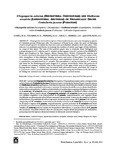Por favor, use este identificador para citar o enlazar este ítem:
http://www.alice.cnptia.embrapa.br/alice/handle/doc/933303Registro completo de metadatos
| Campo DC | Valor | Lengua/Idioma |
|---|---|---|
| dc.contributor.author | COSTA, M. A. | pt_BR |
| dc.contributor.author | TAVARES, W. S. | pt_BR |
| dc.contributor.author | PEREIRA, A. I. A. | pt_BR |
| dc.contributor.author | CRUZ, I. | pt_BR |
| dc.contributor.author | SERRÃO, J. E. | pt_BR |
| dc.contributor.author | ZANUNCIO, J. C. | pt_BR |
| dc.date.accessioned | 2012-09-10T11:11:11Z | pt_BR |
| dc.date.available | 2012-09-10T11:11:11Z | pt_BR |
| dc.date.created | 2012-09-10 | pt_BR |
| dc.date.issued | 2012 | pt_BR |
| dc.identifier.citation | Planta Daninha, Viçosa, MG, v. 30, n. 3, p. 459-468, 2012. | pt_BR |
| dc.identifier.uri | http://www.alice.cnptia.embrapa.br/alice/handle/doc/933303 | pt_BR |
| dc.description | Chrysoperla externa (Neuroptera: Chrysopidae) larvae can avoid foraging on plants of Crotalaria juncea (Fabaceae) after the issuance of floral buds, when the prey of Utetheisa ornatrix (Lepidoptera: Arctiidae) incorporate toxic pyrrolizidine alkaloids from this plant. This reduces the predation and favors increasing the number of adults and eggs of this defoliator on crops of this plant. The aim of the present paper was to evaluate some biological and ecological aspects of C. externa and U. ornatrix on the organic crop of C. juncea in the EMBRAPA Maize and Sorghum in Sete Lagoas, Minas Gerais State, Brazil. Chrysoperla externa and U. ornatrix were more abundant in the vegetative and flowering stages of C. juncea, respectively, with caterpillars of this defoliator feeding on leaves and seeds of this plant. The duration of the stages/instars, survival, lifetime fecundity, and oviposition showed that the branches of C. juncea are a suitable food for U. ornatrix. The abundance of adults and larvae of C. externa was lower in the flowering and pods stages of C. juncea, respectively, when the postures of U. ornatrix are present, probably due to the toxicity of the eggs of this prey to this predator. During these stages, C. externa may be reared with alternative hosts, and when the crops of C. juncea are scarce, an artificial diet should be used for rearing this defoliator in the laboratory for biological research and the development of biological control tactics. | pt_BR |
| dc.language.iso | eng | eng |
| dc.rights | openAccess | eng |
| dc.subject | Manejo integrado de praga | pt_BR |
| dc.title | Chrysoperla externa (Neuroptera: Chrysopidae) and Utetheisa ornatrix (Lepidoptera: arctiidae) on organically grown Crotalaria juncea (Fabaceae). | pt_BR |
| dc.type | Artigo de periódico | pt_BR |
| dc.date.updated | 2017-09-28T11:11:11Z | pt_BR |
| dc.subject.thesagro | Controle biológico | pt_BR |
| dc.subject.thesagro | Larva | pt_BR |
| dc.subject.thesagro | Adubação Verde | pt_BR |
| riaa.ainfo.id | 933303 | pt_BR |
| riaa.ainfo.lastupdate | 2017-09-28 -03:00:00 | pt_BR |
| dc.identifier.doi | 10.1590/S0100-83582012000300001 | pt_BR |
| dc.contributor.institution | IVAN CRUZ, CNPMS; UFV; UFV. | pt_BR |
| Aparece en las colecciones: | Artigo em periódico indexado (CNPMS)  | |
Ficheros en este ítem:
| Fichero | Descripción | Tamaño | Formato | |
|---|---|---|---|---|
| Crysoperlaexterna.pdf | 1,5 MB | Adobe PDF |  Visualizar/Abrir |









